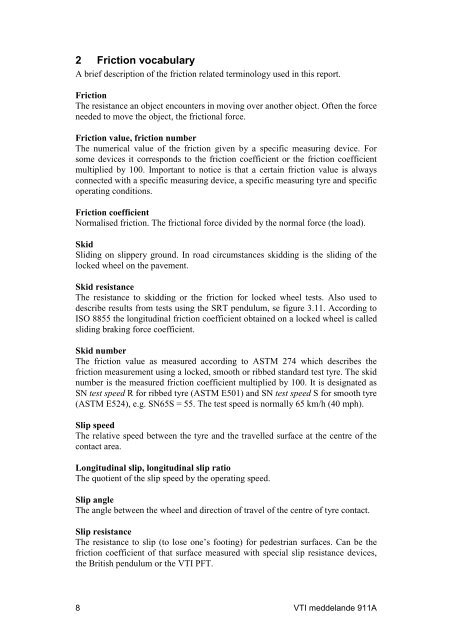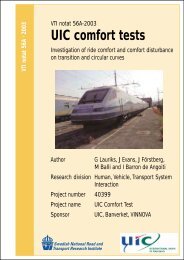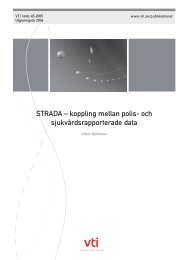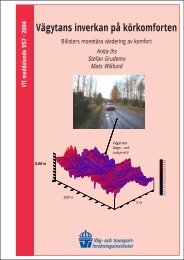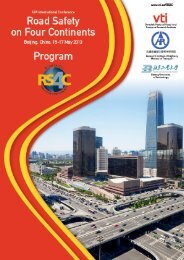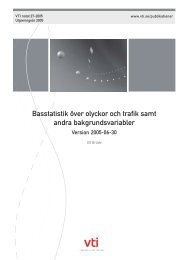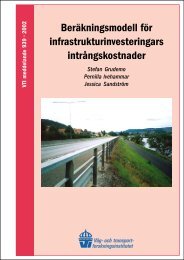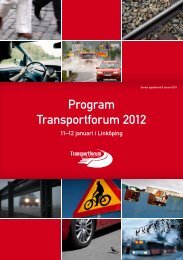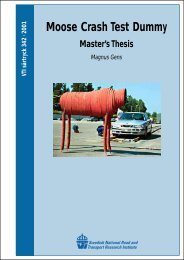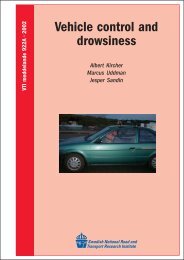Friction measurement methods and the correlation between road - VTI
Friction measurement methods and the correlation between road - VTI
Friction measurement methods and the correlation between road - VTI
You also want an ePaper? Increase the reach of your titles
YUMPU automatically turns print PDFs into web optimized ePapers that Google loves.
2 <strong>Friction</strong> vocabularyA brief description of <strong>the</strong> friction related terminology used in this report.<strong>Friction</strong>The resistance an object encounters in moving over ano<strong>the</strong>r object. Often <strong>the</strong> forceneeded to move <strong>the</strong> object, <strong>the</strong> frictional force.<strong>Friction</strong> value, friction numberThe numerical value of <strong>the</strong> friction given by a specific measuring device. Forsome devices it corresponds to <strong>the</strong> friction coefficient or <strong>the</strong> friction coefficientmultiplied by 100. Important to notice is that a certain friction value is alwaysconnected with a specific measuring device, a specific measuring tyre <strong>and</strong> specificoperating conditions.<strong>Friction</strong> coefficientNormalised friction. The frictional force divided by <strong>the</strong> normal force (<strong>the</strong> load).SkidSliding on slippery ground. In <strong>road</strong> circumstances skidding is <strong>the</strong> sliding of <strong>the</strong>locked wheel on <strong>the</strong> pavement.Skid resistanceThe resistance to skidding or <strong>the</strong> friction for locked wheel tests. Also used todescribe results from tests using <strong>the</strong> SRT pendulum, se figure 3.11. According toISO 8855 <strong>the</strong> longitudinal friction coefficient obtained on a locked wheel is calledsliding braking force coefficient.Skid numberThe friction value as measured according to ASTM 274 which describes <strong>the</strong>friction <strong>measurement</strong> using a locked, smooth or ribbed st<strong>and</strong>ard test tyre. The skidnumber is <strong>the</strong> measured friction coefficient multiplied by 100. It is designated asSN test speed R for ribbed tyre (ASTM E501) <strong>and</strong> SN test speed S for smooth tyre(ASTM E524), e.g. SN65S = 55. The test speed is normally 65 km/h (40 mph).Slip speedThe relative speed <strong>between</strong> <strong>the</strong> tyre <strong>and</strong> <strong>the</strong> travelled surface at <strong>the</strong> centre of <strong>the</strong>contact area.Longitudinal slip, longitudinal slip ratioThe quotient of <strong>the</strong> slip speed by <strong>the</strong> operating speed.Slip angleThe angle <strong>between</strong> <strong>the</strong> wheel <strong>and</strong> direction of travel of <strong>the</strong> centre of tyre contact.Slip resistanceThe resistance to slip (to lose one’s footing) for pedestrian surfaces. Can be <strong>the</strong>friction coefficient of that surface measured with special slip resistance devices,<strong>the</strong> British pendulum or <strong>the</strong> <strong>VTI</strong> PFT.8 <strong>VTI</strong> meddel<strong>and</strong>e 911A


